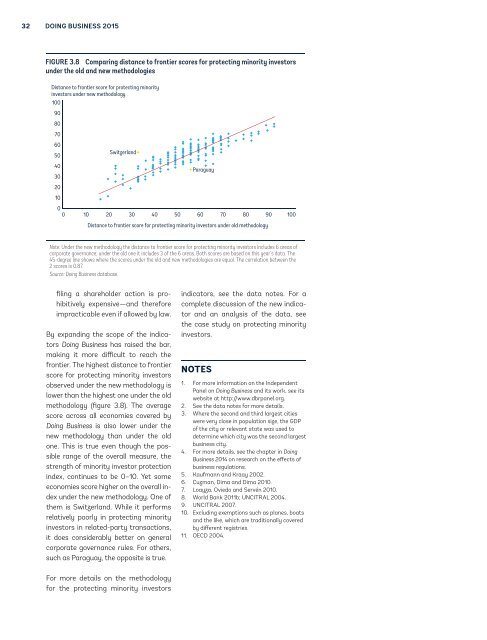bc8G2-7
bc8G2-7
bc8G2-7
Create successful ePaper yourself
Turn your PDF publications into a flip-book with our unique Google optimized e-Paper software.
32<br />
DOING BUSINESS 2015<br />
FIGURE 3.8 Comparing distance to frontier scores for protecting minority investors<br />
under the old and new methodologies<br />
Distance to frontier score for protecting minority<br />
investors under new methodology<br />
100<br />
90<br />
80<br />
70<br />
60<br />
Switzerland<br />
50<br />
40<br />
Paraguay<br />
30<br />
20<br />
10<br />
0<br />
0 10 20 30 40 50 60 70 80 90 100<br />
Distance to frontier score for protecting minority investors under old methodology<br />
Note: Under the new methodology the distance to frontier score for protecting minority investors includes 6 areas of<br />
corporate governance; under the old one it includes 3 of the 6 areas. Both scores are based on this year’s data. The<br />
45-degree line shows where the scores under the old and new methodologies are equal. The correlation between the<br />
2 scores is 0.87.<br />
Source: Doing Business database.<br />
filing a shareholder action is prohibitively<br />
expensive—and therefore<br />
impracticable even if allowed by law.<br />
By expanding the scope of the indicators<br />
Doing Business has raised the bar,<br />
making it more difficult to reach the<br />
frontier. The highest distance to frontier<br />
score for protecting minority investors<br />
observed under the new methodology is<br />
lower than the highest one under the old<br />
methodology (figure 3.8). The average<br />
score across all economies covered by<br />
Doing Business is also lower under the<br />
new methodology than under the old<br />
one. This is true even though the possible<br />
range of the overall measure, the<br />
strength of minority investor protection<br />
index, continues to be 0–10. Yet some<br />
economies score higher on the overall index<br />
under the new methodology. One of<br />
them is Switzerland. While it performs<br />
relatively poorly in protecting minority<br />
investors in related-party transactions,<br />
it does considerably better on general<br />
corporate governance rules. For others,<br />
such as Paraguay, the opposite is true.<br />
indicators, see the data notes. For a<br />
complete discussion of the new indicator<br />
and an analysis of the data, see<br />
the case study on protecting minority<br />
investors.<br />
NOTES<br />
1. For more information on the Independent<br />
Panel on Doing Business and its work, see its<br />
website at http://www.dbrpanel.org.<br />
2. See the data notes for more details.<br />
3. Where the second and third largest cities<br />
were very close in population size, the GDP<br />
of the city or relevant state was used to<br />
determine which city was the second largest<br />
business city.<br />
4. For more details, see the chapter in Doing<br />
Business 2014 on research on the effects of<br />
business regulations.<br />
5. Kaufmann and Kraay 2002.<br />
6. Cuzman, Dima and Dima 2010.<br />
7. Loayza, Oviedo and Servén 2010.<br />
8. World Bank 2011b; UNCITRAL 2004.<br />
9. UNCITRAL 2007.<br />
10. Excluding exemptions such as planes, boats<br />
and the like, which are traditionally covered<br />
by different registries.<br />
11. OECD 2004.<br />
For more details on the methodology<br />
for the protecting minority investors


